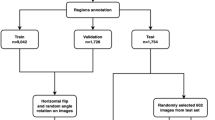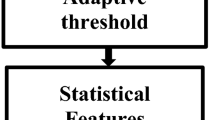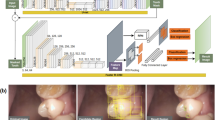Abstract
Objects A neural network was developed to diagnose artificial dental caries using images from a charged-coupled device (CCD)camera and intra-oral digital radiography. The diagnostic performance of this neural network was evaluated against a gold standard.
Materials and methods The neural network design was the Learning Vector Quantization (LVQ) used to classify a tooth surface as sound or as having dental caries. The depth of the dental caries was indicated on a graphic user interface (GUI) screen developed by Matlab programming. Forty-nine images of both sound and simulated dental caries, derived from a CCD camera and by digital radiography, were used to ‘train’ an artificial neural network. After the ’training’ process, a separate test-set comprising 322 unseen images was evaluated. Tooth sections and microscopic examinations were used to confirm the actual dental caries status.The performance of neural network was evaluated using diagnostic test.
Results The sensitivity (95%CI)/specificity (95%CI) of dental caries detection by the CCD camera and digital radiography were 0.77(0.68-0.85)/0.85(0.75-0.92) and 0.81(0.72-0.88)/0.93(0.84-0.97), respectively. The accuracy of caries depth-detection by the CCD camera and digital radiography was 58 and 40%, respectively.
Conclusions The model neural network used in this study could be a prototype for caries detection but should be improved for classifying caries depth. Our study suggests an artificial neural network can be trained to make the correct interpretations of dental caries.
Similar content being viewed by others
References
Douglas CW, Valachovic RW, Wijesinha A, Chauncey HH, Kapur KK, McNeil BJ (1986) Clinical efficacy of dental radiography in the detection of dental caries and periodontal diseases. Oral Surg Oral Med Oral Pathol 62:330–339
Syriopoulos K, Sanderink GC, Velders XL, van der Stelt PF (2000) Radiographic detection of approximal caries: a comparison of dental films and digial imaging systems. Dentomaxillofac Radiol 29:312–318
Abreu M Jr, Mol A, Ludlow JB (2001) Performance of RVGui sensor and Kodak Ektaspeed Plus film for proximal caries detection. Oral Surg Oral Med Oral Pathol Oral Radiol Endod 91:381–385
Wenzel A (2001) Computer-automated caries detection in digital bitewings: consistency of a program and its influence on observer agreement. Caries Res 35:12–20
Wenzel A, Hintze H, Kold LM, Kold S (2002) Accuracy of computer-automated caries detection in digital radiographs compared with human observers. Eur J Oral Sci 110:199–203
Hagan MT, Demuth HB, Beale M (1995) Neural network design. PWS Publishing Co, Boston
Lindahl D, Palmer J, Edenbrandt L (1999) Myocardial SPET: artificial neural networks describe extent and severity of perfusion defects. Clin Physiol 19:497–503
Holst H, Mare K, Jarund A, Astrom K, Evander E, Ohlsso M, Edenbrandt L (2001) An independent evaluation of a new method for automated interpretation of lung scintigrams using artificial neural networks. Eur J Nucl Med 28: 33–38
Mendonça EA (2004) Clinical decision support systems: perspectives in dentistry. J Dent Educ 68:589–597
Boyle EL, Higham SM, Edgar WM (1998) The production of subsurfaced artificial caries lesion on third molar teeth. Caries Res 32:154–158
Speight PM, Elliott AE, Jullien JA, Downer MC, Zakzrewska JM (1995) The use of artificial intelligence to identify people at risk of oral cancer and precancer. Br Dent J 179:382– 387
Brickley MR, Shepherd JP (1997) Comparisons of the abilities of a neural network and three consultant oral surgeons to make decisions about third molar removal. Br Dent J 182: 59–63
Park SW, Heo MS, Lee SS, Choi SC, Park TW, You DS (1999) Artificial neural network system in evaluating cervical lymphnode metastasis of squamous cell carcinoma. Korean J Oral Maxillofac Radiol 29:149–159
Author information
Authors and Affiliations
Corresponding author
Rights and permissions
About this article
Cite this article
Kositbowornchai, S., Siriteptawee, S., Plermkamon, S. et al. An Artificial Neural Network for Detection of Simulated Dental Caries. Int J CARS 1, 91–96 (2006). https://doi.org/10.1007/s11548-006-0040-x
Published:
Issue Date:
DOI: https://doi.org/10.1007/s11548-006-0040-x




